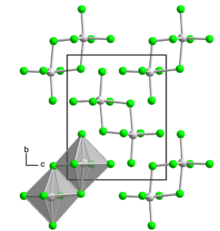Chemistry:Uranium pentachloride

| |
| Names | |
|---|---|
| IUPAC name
Uranium(V) chloride
| |
| Other names
Uranium pentachloride
Uranic chloride | |
| Identifiers | |
3D model (JSmol)
|
|
| ChemSpider | |
PubChem CID
|
|
| |
| |
| Properties | |
| UCl5 | |
| Molar mass | 415.29 g/mol |
Except where otherwise noted, data are given for materials in their standard state (at 25 °C [77 °F], 100 kPa). | |
| Infobox references | |
Uranium pentachloride is an inorganic chemical compound composed of uranium in the +5 oxidation state and five chlorine atoms.
Preparation
Uranium pentachloride can be prepared from the reaction of uranium trioxide with carbon tetrachloride, with a previously prepared amount of the compound serving as a catalyst.[1]
- 4 UO3 + 10 CCl4 → 4 UCl5 + 10 COCl2 + O2
It can also be prepared from the reaction between uranium tetrachloride and chlorine in a fluidized bed reactor at 550 °C.[1]
Properties
Uranium pentachloride is available as red-brown microcrystalline powders or black-red crystals with metallic sheen. Unlike the tetrachloride, it is soluble in liquid chlorine. It is very hygroscopic and decomposes into uranium hexachloride and uranium tetrachloride when in water or heated. Additionally, it reacts with some organic solvents such as alcohols, acetone, diethyl ether, or dioxane, but does form stable solutions in carbon tetrachloride, carbon disulfide, and thionyl chloride.
There are two crystalline forms, each of which has the uranium atom in an octahedral geometry among six chlorine atoms. Usually, it is in the α-form, which has a monoclinic crystal structure with space group P21/n. There is also a triclinic β-form, which has space group P1[2] and consists of U
2Cl
10 dimers like in uranium pentabromide.[3]
The gaseous form has C4v symmetry due to strong f-orbital contribution, and has an electron affinity of 4.76±0.03 eV.[4]
References
- ↑ 1.0 1.1 Brauer, Georg (1975). Handbuch der präparativen anorganischen Chemie, vol. 1 (3rd ed.). Stuttgart: Enke. p. 1208. ISBN 3-432-02328-6. OCLC 310719485.
- ↑ The Chemistry of the Actinide and Transactinide Elements. pp. 522–523.
- ↑ Levy, J.H.; Taylor, J.C.; Wilson, P.W. (1978-01-01). "The crystal structure of uranium pentabromide by powder neutron diffraction" (in en). Journal of Inorganic and Nuclear Chemistry 40 (6): 1055–1057. doi:10.1016/0022-1902(78)80507-7. ISSN 0022-1902. https://www.sciencedirect.com/science/article/abs/pii/0022190278805077. Retrieved 29 May 2021.
- ↑ Su, J; Dau, P. D.; Xu, C. F.; Huang, D. L.; Liu, H. T.; Wei, F; Wang, L. S.; Li, J (2013). "A joint photoelectron spectroscopy and theoretical study on the electronic structure of UCl5- and UCl5". Chemistry: An Asian Journal 8 (10): 2489–96. doi:10.1002/asia.201300627. PMID 23853153.
 |

